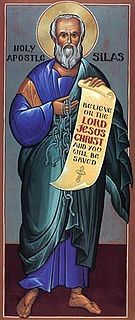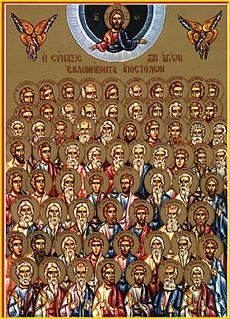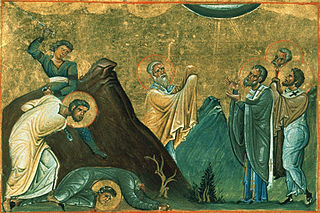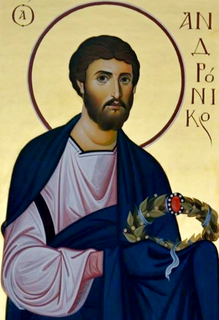
Agabus was an early follower of Christianity mentioned in the Acts of the Apostles as a prophet. He is traditionally remembered as one of the Seventy Disciples described in Luke 10:1–24.

Silas or Silvanus was a leading member of the Early Christian community, who first accompanied Paul the Apostle on his second missionary journey.
An apostolic see is an episcopal see whose foundation is attributed to one or more of the apostles of Jesus or to one of their close associates. In Catholicism the phrase, preceded by the definite article and usually capitalized, refers to the See of Rome.

Philip the Evangelist appears several times in the Acts of the Apostles. He was one of the Seven chosen to care for the poor of the Christian community in Jerusalem. He preached and reportedly performed miracles in Samaria, and met and baptised an Ethiopian man, a eunuch, on the road from Jerusalem to Gaza, traditionally marking the start of the Ethiopian Church. Later, Philip lived in Caesarea Maritima with his four daughters who prophesied, where he was visited by Paul the Apostle.
Silvanus or Sylvanus may refer to:

The seventy disciples or seventy-two disciples were early emissaries of Jesus mentioned in the Gospel of Luke. According to Luke, the only gospel in which they appear, Jesus appointed them and sent them out in pairs on a specific mission which is detailed in the text.

According to Eastern Christian tradition, Thaddeus of Edessa was one of the seventy disciples of Jesus. He is possibly identical with Thaddaeus, one of the Twelve Apostles. From an early date his hagiography is filled with legends and fabrications. The saint himself may be entirely fictitious.

Quartus was an early Christian who is mentioned in the Bible.

Andronicus of Pannonia was a 1st-century Christian mentioned by the Apostle Paul in his Epistle to the Romans :
Salute Andronicus and Junia, my kinsmen, and my fellow prisoners, who are of note among the apostles, who also were in Christ before me.

Erastus of Corinth, also known as Erastus of Paneas, held the political office of steward, in Corinth, according to the Epistle to the Romans 16:23 of the New Testament. The office is defined as "the manager of household or of household affairs" or, in this context, "treasurer". The King James Version uses the translation "chamberlain", while the New International Version uses "director of public works". A person named Erastus mentioned in 2 Timothy and Acts is usually taken to be the same person.

Epenetus or Epaentus is a saint in the Greek Orthodox Church and Roman Catholic Church, considered one of the seventy disciples and may have been the first Bishop of Carthage or Cartagena. In the 16th chapter of St. Paul's letter to the Romans, Epenetus is referred to by Saint Paul as "my beloved" and given the great distinction of being named the "first convert in the Province of Asia".

Achaicus was a Corinthian Christian who according to the Bible, together with Fortunatus and Stephanas, carried a letter from the Corinthians to St. Paul, and from St. Paul to the Corinthians.

Aristobulus of Britannia is a Christian saint named by Hippolytus of Rome (170-235) and Dorotheus of Gaza (505-565) as one of the Seventy Disciples mentioned in Luke 10:1–24 and as the first bishop in Roman Britain.

Herodion of Patras was a relative of Saint Paul whom Paul greets in Romans 16:11. According to tradition, he was numbered among the Seventy Disciples and became bishop of Patras, where he suffered greatly. After beating, stoning, and stabbing him, they left him for dead, but St. Herodion arose and continued to serve the Apostles.

Rufus of Thebes is numbered among the Seventy Disciples in Eastern Orthodox tradition. He was bishop of Thebes in Greece, and according to some traditions is referenced in Romans 16:13. His feast day is April 8. However according to Easton's Bible Dictionary the Rufus in Romans 16 could well have been the Rufus mentioned in Mark.
Jason of Thessalonica was a Jewish convert and early Christian believer mentioned in the New Testament in Acts 17:5–9 and Romans 16:21. According to tradition, Jason is numbered among the Seventy Disciples.

Sosipater is a person mentioned in the New Testament, in Romans 16:21. He is probably the same person as Sopater mentioned in Acts 20:4.

According to the New Testament book of Romans, Tertius of Iconium acted as an amanuensis for Paul the Apostle, writing down his Epistle to the Romans. He is numbered among the Seventy Disciples in a list pseudonymously attributed to Hippolytus of Rome, which is found in the margin of several ancient manuscripts.
Fortunatus is person mentioned by St Paul in I Corinthians 16:17: I was glad when Stephanas, Fortunatus, and Achaicus arrived, because they have supplied what was lacking from you.
Mark the cousin of Barnabas is a figure mentioned in the New Testament, usually identified with John Mark.











